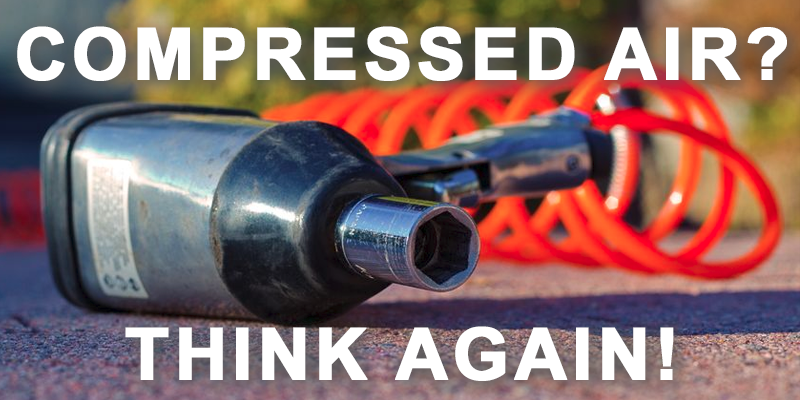
I know this might sound strange from a guy who's all about compressed air... ... but did you ever wonder WHY and IF you really need to use compressed air? It might have been a very bad decision to make use of compressed air for your tools, machines, actuators, etc. Sure, some applications DEMAND compressed air. It's simply the only real option for it. And I know, compressed air and has many upsides: - compressed air tools are very powerful - they are safe to use - can operate in very dirty environments - are cheaper compared to their electrical counterparts - can last a lifetime. I love all the benefits that using compressed air for your application brings.. but there is one very big downside.. Compressed air is EXPENSIVE. Very expensive. In fact, it's 7x - 8x more expensive compared to electricity. Just yesterday I was doing some research for an up and coming course I am creating (in fact, I'm creating TWO new courses on compressed air, click here to stay updated and be the first to know). I talked about the cost of compressed air. And here's an example that shows exactly how and why using compressed air is 7x more expensive than electricity. Here's a slide from my new course on compressed air basics (the course is called 'Compressed Air Confidence', more info here) 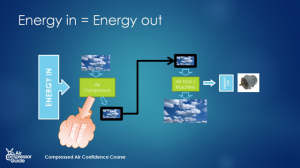 As you can see, we put in a lot of (electrical) energy to compress the ambient air. When compressing air, we waste a lot of energy to... heat. We can't 'destroy' energy. We can only transform energy. Energy in = Energy out. Energy in = energy out. Always. So nothing is lost. But we can have 'useful' energy and 'useless' energy. In the case of the air compressor, the generated heat is mostly useless and we just try our best to get rid of it (which might even be a problem by itself, especially in hot climates). If we're lucky, we can use heat-recovery to 'capture' some of the heat and do something useful with it, like heating water for the shower or heating up a cold factory space. Of all the energy we put into the compressor, most of it is wasted before we can use it at the point of use (pneumatic tools, machines, etc). In fact, for every 100HP input, only 7 - 14 HP will be left over when we use the compressed air in our application. Don't believe me? Here's a concrete example 2 HP compressed air motor VS 2 HP electric motor I found 2 comparable motors. A compressed air one, and an electric one. They have the same shaft output power, and about the same rotational speed.
As you can see, we put in a lot of (electrical) energy to compress the ambient air. When compressing air, we waste a lot of energy to... heat. We can't 'destroy' energy. We can only transform energy. Energy in = Energy out. Energy in = energy out. Always. So nothing is lost. But we can have 'useful' energy and 'useless' energy. In the case of the air compressor, the generated heat is mostly useless and we just try our best to get rid of it (which might even be a problem by itself, especially in hot climates). If we're lucky, we can use heat-recovery to 'capture' some of the heat and do something useful with it, like heating water for the shower or heating up a cold factory space. Of all the energy we put into the compressor, most of it is wasted before we can use it at the point of use (pneumatic tools, machines, etc). In fact, for every 100HP input, only 7 - 14 HP will be left over when we use the compressed air in our application. Don't believe me? Here's a concrete example 2 HP compressed air motor VS 2 HP electric motor I found 2 comparable motors. A compressed air one, and an electric one. They have the same shaft output power, and about the same rotational speed.
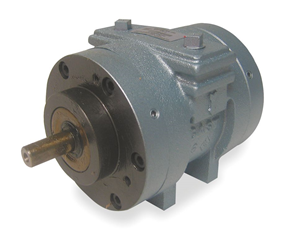
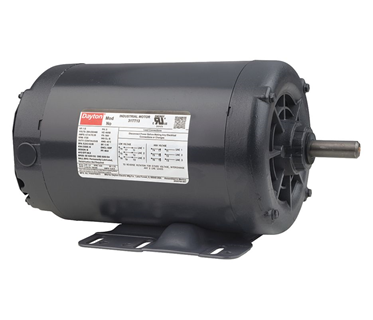 2HP compressed air motor 2HP electric motor In reality, the compressed air motor is half as big and only 1/3 of the weight of the electric motor! Energy needed How much energy do we need to power these motors? Let's check the specifications and do some calculations! How much electrical energy do we need to power the 2 HP electric motor? Quite simple, the output power divided by the efficiency. How much electrical energy do we need to power our compressed air motor? From the motor specs can get the compressed air requirements. Compressed air motor: Electrical motor: 80 psi (5.5 bar) 68 cfm (32 l/s or 115 m3/hr) 2 HP shaft power 86.5% efficiency (taken from the specs) Electrical input power: 2 / 0.865) = 2.3 HP (= 1.7 kW) Alright, that doesn't really tell me anything (yet!). Now let's find an air compressor that can give us the required compressed air. For example, we could use the following air compressor: Chicago Pneumatic QRS 20.
2HP compressed air motor 2HP electric motor In reality, the compressed air motor is half as big and only 1/3 of the weight of the electric motor! Energy needed How much energy do we need to power these motors? Let's check the specifications and do some calculations! How much electrical energy do we need to power the 2 HP electric motor? Quite simple, the output power divided by the efficiency. How much electrical energy do we need to power our compressed air motor? From the motor specs can get the compressed air requirements. Compressed air motor: Electrical motor: 80 psi (5.5 bar) 68 cfm (32 l/s or 115 m3/hr) 2 HP shaft power 86.5% efficiency (taken from the specs) Electrical input power: 2 / 0.865) = 2.3 HP (= 1.7 kW) Alright, that doesn't really tell me anything (yet!). Now let's find an air compressor that can give us the required compressed air. For example, we could use the following air compressor: Chicago Pneumatic QRS 20. 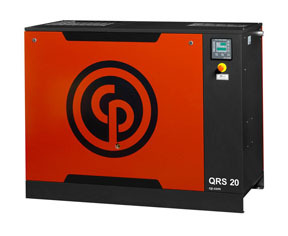 Specs for this compresssor: 100 psi (6.9 bar) 85 CFM (40l/s or 144 m3/hr) (I just picked one, it could be any other brand or model with the same specs). From the datasheet we learn that this compressor consumes 21.3 HP (or 15.9 kW) at full power. But this is a 100psi unit and we don't need 100psi, we just need 80. And we don't need 85 CFM, we just need 68 for our motor. Adjusted for these values (I will save the calculations for another post), we still need 13.5 HP (which is 10.1 kW) electrical input to generate the required compressed air of 68 CFM at 80 psi Or, we could have used the following Rule of thumb: Air compressors deliver 4 to 5 CFM (at 100 psi) per HP input power In metric units: Air compressor deliver 2.5 to 3.2 l/s (at 6.9 bar) per kW input power Using this rule of thumb, we come to about the same values, so this rule of thumb should be about right. Yearly costs compared Let's assume we use the motor for a full 1-shift work week for the whole year, which is 2080 hours. And lets assume electricity costs us $0.05 per kWh. Compressed air motor: Electrical motor: 10.1 kW x 2080 hrs x $0.05 = $1050 1.7 kW x 2080 hrs x $0.05 kWh = $104 The compressed air motor costs of a whooping $1050 per year to operate, compare to only $104 for the electric motor, which is about 10 times more expensive! Consider the energy cost of compressed air Next time you buy a power tool or design a machine.. compare the operational costs of a compressed air part (motor, piston, actuator, gripper, etc) tot that of it's electrical equivalent. I know that using compressed air is in many cases so much easier (to design, to install, to use, to maintain). But considering the potential energy savings (year after year), sometimes it's worth thinking about an alternative! For example, the above compressed air motor costs around $1.000, the electric motor around $420. And that compressor sets you back about $10.000 10 years of use After 10 years, the electric options would have cost you 420 (motor purchase) + (10 * 104 electricity) = $1460 The compressed air options would have cost you $10.000 (compressor) + $1000 (motor) + (10 * 1050 electricity) = $21.500 Compressed air motor: Electrical motor: Total cost after one year: $21.500 Total cost after one year: $1460 Even if we would need to spend a thousand or 2 on electrical cables, cabinet and motor starter for the electric motor option, it would still be way cheaper! .. even if the electric motor burns out every other year! Conclusion I know the comparison is not complete or 100% precise, but it's food for thought! Many times, using compressed air is just simply to only real option, because of adverse working conditions, needed reliability, availability of spare-parts, etc.
Specs for this compresssor: 100 psi (6.9 bar) 85 CFM (40l/s or 144 m3/hr) (I just picked one, it could be any other brand or model with the same specs). From the datasheet we learn that this compressor consumes 21.3 HP (or 15.9 kW) at full power. But this is a 100psi unit and we don't need 100psi, we just need 80. And we don't need 85 CFM, we just need 68 for our motor. Adjusted for these values (I will save the calculations for another post), we still need 13.5 HP (which is 10.1 kW) electrical input to generate the required compressed air of 68 CFM at 80 psi Or, we could have used the following Rule of thumb: Air compressors deliver 4 to 5 CFM (at 100 psi) per HP input power In metric units: Air compressor deliver 2.5 to 3.2 l/s (at 6.9 bar) per kW input power Using this rule of thumb, we come to about the same values, so this rule of thumb should be about right. Yearly costs compared Let's assume we use the motor for a full 1-shift work week for the whole year, which is 2080 hours. And lets assume electricity costs us $0.05 per kWh. Compressed air motor: Electrical motor: 10.1 kW x 2080 hrs x $0.05 = $1050 1.7 kW x 2080 hrs x $0.05 kWh = $104 The compressed air motor costs of a whooping $1050 per year to operate, compare to only $104 for the electric motor, which is about 10 times more expensive! Consider the energy cost of compressed air Next time you buy a power tool or design a machine.. compare the operational costs of a compressed air part (motor, piston, actuator, gripper, etc) tot that of it's electrical equivalent. I know that using compressed air is in many cases so much easier (to design, to install, to use, to maintain). But considering the potential energy savings (year after year), sometimes it's worth thinking about an alternative! For example, the above compressed air motor costs around $1.000, the electric motor around $420. And that compressor sets you back about $10.000 10 years of use After 10 years, the electric options would have cost you 420 (motor purchase) + (10 * 104 electricity) = $1460 The compressed air options would have cost you $10.000 (compressor) + $1000 (motor) + (10 * 1050 electricity) = $21.500 Compressed air motor: Electrical motor: Total cost after one year: $21.500 Total cost after one year: $1460 Even if we would need to spend a thousand or 2 on electrical cables, cabinet and motor starter for the electric motor option, it would still be way cheaper! .. even if the electric motor burns out every other year! Conclusion I know the comparison is not complete or 100% precise, but it's food for thought! Many times, using compressed air is just simply to only real option, because of adverse working conditions, needed reliability, availability of spare-parts, etc.

Comments
No comments yet…
Log in or create an account to make a comment...